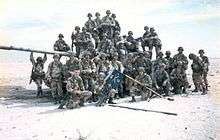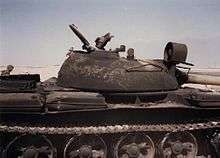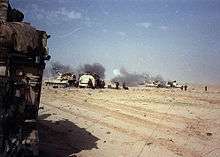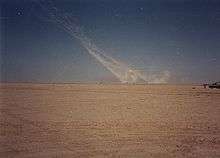Battle of Norfolk
| ||||||||||||||||||||||||||||||
The Battle of Norfolk was a tank battle fought on February 27, 1991, during the Persian Gulf War, between armored forces of the United States and United Kingdom, and those of the Ba'athist Iraqi Republican Guard. It was the final battle of the war before the unilateral ceasefire took effect. Two more battles would occur at Objective Dorset and near the oil field at Rumaila after the ceasefire.[22][23] The Battle of Norfolk has generally been overlooked especially when considering the sheer size of the battle. No fewer than 14 divisions participated in the Battle of Norfolk, making it perhaps the largest battle of the war, though the Battle of Medina Ridge involved the largest American and Iraqi divisions.[15][24] Over a decade passed after the conflict before quality references became available on most of the battles that took place during the 1st Gulf War. Many of the land battles during Operation Desert Storm were larger than the majority of the battles that took place in southern and western Europe during World War Two, at least as far as the quantity of equipment involved.
Overview
The battle took place about 60 miles (97 km) east of and 18 hours after the Battle of Al Busayyah, and several kilometers east of the Battle of 73 Easting, which had ended just two hours earlier. The Battle of Norfolk is named for Objective Norfolk, an area that encompassed the intersection of the IPSA Pipeline Road and several desert trails and a large Iraqi supply depot defended by Iraqi armor. Objective Norfolk was located west of Phase Line Kiwi, east of Phase Line Smash, and north of Phase Line Grape. Phase lines are map references occurring every few kilometers used to measure progress of an offensive operation.[25]
Participants
The forces involved in the battle were the American 1st Infantry Division, the 3rd Brigade of the 2nd Armored Division (Fwd) ('Hell on Wheels') and the Iraqi 18th Mechanized and 9th Armoured Brigades of the Republican Guard Tawakalna Mechanized Infantry Division along with elements from eleven other Iraqi divisions including the Iraqi 26th, 48th, 31st, and 25th Infantry Divisions.[26] The Iraqi 52nd Armoured Division was also a participant.[21] The Iraqi 10th and 12th Armoured Divisions were also present. The Iraqis also had elements of two other independent armoured brigades in theatre, those being the 50th and 29th Armoured Brigades.[27] The British fielded their 1st Armoured Division.[28]
Counter reconnaissance
Task Force 1-41 Infantry was a heavy battalion task force from the 2nd Armored Division (Forward). It consisted primarily of the 1st Battalion, 41st Infantry Regiment, 3rd Battalion, 66th Armor Regiment, and the 4th Battalion, 3rd Field Artillery Regiment. Task Force 1-41 was the first coalition force to breach the Saudi Arabian border on 15 February 1991 and conduct ground combat operations in Iraq engaging in direct and indirect fire fights with the enemy on 17 February 1991.[29] Shortly after arrival in theatre Task Force 1-41 Infantry received a counter-reconnaissance mission along with the 1st Squadron, 4th Cavalry Regiment.[30] This joint effort became known as Task Force Iron.[31] Counter-reconnaissance generally includes destroying or repelling the enemy's reconnaissance elements and denying their commander any observation of friendly forces. On 15 February 1991 4th Battalion of the 3rd Field Artillery Regiment fired on a trailer and a few trucks in the Iraqi sector that was observing American forces.[32] On 16 February 1991 several groups of Iraqi vehicles appeared to be performing reconnaissance on the Task Force and were driven away by fire from 4-3 FA.[33] Another enemy platoon, including six vehicles, was reported as being to the northeast of the Task Force. They were engaged with artillery fire from 4-3 FA.[34] Later that evening another group of Iraqi vehicles was spotted moving towards the center of the Task Force. They appeared to be Iraqi Soviet-made BTRs and tanks. For the next hour the Task Force fought several small battles with Iraqi reconnaissance units. TF 1-41 IN fired TOW missiles at the Iraqi formation destroying one tank. The rest of the formation was destroyed or driven away by artillery fire from 4-3 FA.[34] On 17 February 1991 the Task Force took enemy mortar fire, however, the enemy forces managed to escape.[35] Later that evening the Task Force received enemy artillery fire but suffered no casualties.[36]




Breach
The breach was preceded by a heavy artillery barrage, led by 4th Battalion of the 3rd Field Artillery Regiment and the 210th Field Artillery Brigade, to soften up Iraqi defenses. Around 300 guns from multiple nations participated in the barrage. Over 14,000 rounds of artillery and over 4,900 MLRS rockets were fired at Iraqi forces during these raids.[4] Iraq lost close to 22 artillery battalions during the initial stages of this barrage.[19] This would include the destruction of approximately 396 Iraqi artillery pieces.[19] By the end of these raids Iraqi artillery assets had all but ceased to exist. These raids were supplemented by air attacks by B-52 Stratofortress bombers and C-130 cargo aircraft.[37]
Task Force 1-41 Infantry was given the task of breaching Iraq's initial defensive positions along the Iraq-Saudi Arabia border. It was assisted once again by the 1st Squadron, 4th Armored Cavalry Regiment. Once into Iraqi territory the Task Force encountered multiple Iraqi defensive positions and bunkers. These defensive positions were occupied by a brigade-sized element.[38] TF 1-41 IN elements dismounted and prepared to engage the enemy soldiers which occupied these well-prepared and heavily fortified bunkers.[38] The Task Force found itself engaged in six hours of combat in order to clear the extensive bunker complex.[38] The Iraqis engaged the Task Force with small arms fire, RPGs, mortar fire, and what was left of Iraqi artillery assets. A series of battles unfolded which resulted in heavy Iraqi casualties and the Iraqis being removed from their defensive positions with many becoming prisoners of war. Some escaped to be killed or captured by other coalition forces.[39] In the process of clearing the bunkers Task Force 1-41 captured two brigade command posts and the command post of the Iraqi 26th Infantry Division.[40] The Task Force also captured a brigade commander, several battalion commanders, company commanders, and staff officers.[40] As combat operations progressed Task Force 1-41 Infantry engaged at short range multiple dug in enemy tanks in ambush positions.[29] Task Force 1-41 earned a Valorous Unit Award for its efforts.[38]
Battle
The Battle of Norfolk was in a sense a continuation of the fighting that began with the Battle of 73 Easting the day before. It began at 0030 on 27 February. The two attacking brigades of the U.S. 1st Infantry Division, including the 3rd Brigade of the 2nd Armored Division (Fwd), were positioned along the 75 Easting, 2,000 meters east of 73 Easting. The Brigades clashed with the Iraqi Tawakalna Division of the Republican Guard, including the 37th Brigade of the 12th Iraqi Armored Division.[25] The Iraqi 12th Armored Division was destroyed during this engagement. Some 40 Iraqi tanks were destroyed and a similar number of other combat vehicles.[14]
With air support from the 2nd Battalion, 1st Aviation's attack helicopters[41] and fire support from both the 4th Battalion of the 3rd Field Artillery Regiment and the 210th Field Artillery Brigade preventing Iraqi artillery from interfering, the U.S. 1st Infantry Division conducted a passage of the 2nd ACR's lines.[42] In the following three hours the U.S. 1st Infantry Division methodically crossed the 6.2 miles (10.0 km) of Objective Norfolk, destroying Iraqi tanks, trucks, and infantry through thick fog. The 3rd Brigade of the 2nd Armored Division (Fwd) destroyed 60 Iraqi tanks and 35 AFVs along the IPSA pipeline.[15] In the thick of the fog of war, U.S. units became mixed with Iraqi units dispersed throughout the desert. This confusion led to some friendly fire incidents.[43]
The 1st Squadron, 4th Armored Cavalry Regiment led the 1st Infantry Division's attack across Iraq and Kuwait, cutting the Iraqi army's escape route along the Kuwait City/Basra Highway. The Squadron continued its rapid advance, culminating with the capture of the Safwan Airfield, Iraq. The 1st Squadron, 4th Armored Cavalry Regiment destroyed 65 tanks, 66 Armored Personnel Carriers, 66 trucks, 91 bunkers, and captured 3,010 enemy soldiers.[44]
By dawn, the U.S. 1st Infantry Division controlled Objective Norfolk and the Tawakalna Mechanized Infantry Division had ceased to exist as a fighting force. A total of eleven Iraqi divisions were destroyed. American casualties were six soldiers killed (all but one by friendly fire) and 25 wounded.[10] Task Force 1-41 Infantry had around a dozen combat vehicles destroyed, including multiple M1A1 Abrams tanks, during combat operations.
On 28 February the U.S. 3rd Armored Division cleared Objective Dorset after meeting stiff resistance and destroying more than 250 enemy vehicles.[45] The 3rd Brigade, 3rd Armored Division also captured 2,500 enemy prisoners.[46] The 3rd Brigade, 3rd Armored Division actions contributed greatly to the destruction of two Iraqi Republican Guard Divisions.[47] In 24 hours of nearly continuous combat, the Brigade destroyed or captured 547 vehicles, including 102 tanks, 81 armored personnel carriers, 34 artillery pieces, 15 AAA guns and captured hundreds of tons of supplies and 528 prisoners of war.[48] The 3rd Armored Division had three M1A1 Abrams tanks damaged during combat operations.[49][50] Fifteen troops of the 3rd AD were killed between December 1990 and late February 1991.
British participation
The British 1st Armoured division was responsible for protecting the right flank of VII Corps. It was assumed by the Corps' planners the Iraqi 52nd Armored Division would counterattack VII Corps once their penetration into Iraqi defenses was discovered. The British 1st Armoured Division had two brigades (the 4th and 7th) which participated in Operation Granby, the name given to the British military operations during the 1991 Gulf War. The 1st Armoured was equipped with the Challenger 1 main battle tank. With a 120mm rifled main gun, thermal optics, and state of the art Chobham armor, its only rival in-theatre was the American M1A1 Abrams tank. British infantry rode into battle on the Warrior tracked armoured vehicle. It had reasonable armor protection and a 30-mm gun. Modified versions of the vehicle included mortar carriers, MILAN antitank systems, and command and control vehicles; and the British possessed a variety of excellent light armoured vehicles built on their FV101 Scorpion chassis. British artillery was primarily American made M109 howitzers (155mm), M110 howitzers (203mm), and M270 MLRS which were compatible with American systems. Their air support consisted of Gazelle helicopters, used for reconnaissance, and the Lynx helicopter which was comparable to the American AH-1 Cobra. The British had their full contingent of engineer, logistics, and medical units.[28]
This small but powerful division was commanded by forty-seven-year-old Maj. General Rupert Smith. He was a member of the British Parachute Regiment and an expert on Soviet armour and tank tactics. His division had two brigades at its disposal. The 4th Brigade was reinforced with extra engineers and artillery. The 4th Brigade was used for breakout operations and to clear the ground at the breach. The armour heavy 7th Brigade was used for tank on tank engagements.[51]
On 25 February 1991 the 1st Armoured Division broke into the western flank of the Iraqi 48th Infantry Division which was commanded by Brigadier General Saheb Mohammed Alaw. That night the 48th Infantry Division was destroyed and General Alaw was captured by the British. That same night the British cleared two lines of enemy positions during close combat engagements. The British also destroyed several Iraqi companies of T-55 tanks.[20] That same night other elements of the division were engaging the Iraqi 31st Infantry Division.[20]
On 26 February 1991 British artillery units unleashed an hour long artillery strike on Iraqi positions. It was the greatest British artillery display since World War II. That same night the British 7th Brigade fought a night tank battle against an Iraqi tank battalion from the Iraqi 52nd Armored Division. After ninety minutes of battle over 50 Iraqi tanks and armored personnel carriers were destroyed.[20] That same night the British 4th Brigade destroyed a headquarters and artillery site belonging to the 807th Brigade of the Iraqi 48th Infantry Division. British infantry units cleared Iraqi defensive positions which were occupied by the Iraqi 803rd Infantry Brigade.[52] After 48 hours of combat the British 1st Armoured Division destroyed or isolated four Iraqi infantry divisions (the 26th, 48th, 31st, and 25th) and overran the Iraqi 52nd Armored Division in several sharp engagements. By midnight there was no more organized Iraqi resistance between the 1st Armoured Division and the Persian Gulf.[21]
On 27 February 1991 the British 1st Armoured Division secured the final objectives on the Basra Highway north of Multa Ridge.[21] The British 1st Armoured Division had traveled 217 miles in 97 hours. The 1st Armored Division had captured or destroyed about 200 tanks and a very large number of armoured personnel carriers, trucks, reconnaissance vehicles, etc.[20][21]

See also
- Persian Gulf War
- Battle of 73 Easting
- Task Force 1-41
- History of the M1 Abrams
- Republican Guard (Iraq)
- M109 howitzer
- M1 Abrams
- Division (military)
- Task force
- Regiment
- Brigade
- Battalion
Citations
- ↑ Bourque, p.14
- ↑ Bourque, p.43
- ↑ Bourque P.247
- 1 2 Bourque, p.164
- ↑ Bourque P.252
- ↑ Bourque pp.331,335
- 1 2 Bourque, p.333
- ↑ Bourque pp.134,144,377
- ↑ Bourque P.337
- 1 2 Rostker Tab H
- 1 2 Guardia p.71
- 1 2 Bourque, p.336
- ↑ Bourque, p.460
- 1 2 3 Westwell, p. 88
- 1 2 3 Zaloga (2009), p. 64
- ↑ VUA Citation
- ↑ Zaloga (2009), p.64
- ↑ Westfall P.89
- 1 2 3 Bourque P.161
- 1 2 3 4 5 Bourque, p.275
- 1 2 3 4 5 Bourque, p.377
- ↑ VUA Citation
- ↑ Conduct of the Persian Gulf War: final report to Congress p.339
- ↑ Bourque, pp.144, 260, 275, 377
- 1 2 Bourque, p.134
- ↑ Bourque, p.144
- ↑ Bourque P.333, P.337
- 1 2 Bourque, p.260
- 1 2 VUA Citation.
- ↑ Hillman, p.6
- ↑ Bourque & Burdan p.95
- ↑ Bourque, p.96
- ↑ Bourque, p.98
- 1 2 Bourque, p.99
- ↑ Bourque, p. 102
- ↑ Bourque, p.103
- ↑ Bourque pp.163
- 1 2 3 4 Desert Storm/Shield Valorous Unit Award Citations
- ↑ Bourque, pp.113-133
- 1 2 Bourque P.259
- ↑ Bourque, p.330
- ↑ Bourque, p.331
- ↑ Bourque, p.100
- ↑ VUA Citation
- ↑ Conduct of the Persian Gulf War: final report to Congress p.339
- ↑ VUA Citation
- ↑ VUA Citation
- ↑ VUA Citation
- ↑ Scales, Brig. Gen. Robert H.: Certain Victory. Brassey's, 1994, p. 279.
- ↑ official account
- ↑ Bourque, p.261
- ↑ Bourque, p.276
Works consulted
- Conduct of the Persian Gulf War: final report to Congress (PDF), United States. Dept. of Defense, 1992
- "Desert Storm/Shield Valorous Unit Award (VUA) Citations". US Army Center of Military History. Retrieved 26 December 2014.
- Bourque, Stephen A. (2001). Jayhawk! The 7th Corps in the Persian Gulf War. Center of Military History, United States Army. LCCN 2001028533. OCLC 51313637.
- Bourque, Stephen A.; Burdan, John (2007). The road to Safwan the 1st Squadron, 4th Cavalry in the 1991 Persian Gulf War. Denton, Tex: University of North Texas Press. ISBN 9781574412321.
- Rostker, Bernard (2000), Environmental Exposure Report, Depleted Uranium in the Gulf (II), US Department of Defense
- Westwell, Ian (2001). 1st Infantry Division 'Big Red One'. Spearhead #6. Hersham, Surrey: Ian Allen. ISBN 9780711029231.
- Zaloga, Steven J. (2009). M1 Abrams vs T-72 Ural:Operation Desert Storm 1991. Osprey. ISBN 9781846034077. OCLC 277201894.
- Guardia, Mike (2016). Bradley vs BMP : Desert Storm 1991. Random House. ISBN 978-1-4728-1520-0.
Bibliography
- Crusade: The Untold Story of the Persian Gulf War, by Rick Atkinson, Houghton Mifflin, 1993. ISBN 0395710839 OCLC 28378277
